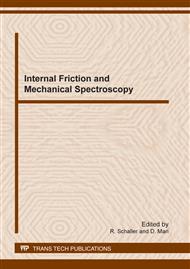p.393
p.399
p.405
p.411
p.416
p.422
p.428
p.434
p.443
Mechanical Spectroscopy Study on the Light Soaking Effect on Hydrogenated Amorphous Silicon
Abstract:
For hydrogenated amorphous silicon (a-Si:H) films deposited at temperatures between 423 K and 623 K (a-Si:H423K and so on), the light-induced changes in the internal friction between 80 K and 400 K were studied. The internal friction is associated with H2 motion in microvoid networks, and shows the mild temperature dependence between about 80 K and 300 K (Q-180-300K) and the almost linear increase above 300 K (Q-1>300K). Both Q-180-300K and Q-1>300K decrease with increasing the deposition temperature, and show the mild temperature dependence in a-Si:H623K. The white light soaking with 100 mW/cm2 (WLS100 and so on) below 300 K caused a change in Q-180-300K and no changes in Q-1>300K, respectively, and the light-induced changes in Q-180-300K recovered after annealing at 423 K. The wide distribution of activation energies for H2 motions between microvoids indicate that most of neighboring microvoids are connected through windows, i.e., the microvoid networks are existing in a-Si:H, and the spatially loose or solid structures are responsible for the low or high activation energies for the H2 motion between microvoids, respectively. Furthermore, the light-induced hydrogen evolution (LIHE) was observed for WLS200 to WLS400 in a vacuum between 400 and 500 K, resulting in the disappearance of the internal friction due to the H2 motion in the microvoid network.
Info:
Periodical:
Pages:
416-421
Citation:
Online since:
January 2012
Authors:
Price:
Сopyright:
© 2012 Trans Tech Publications Ltd. All Rights Reserved
Share:
Citation:


